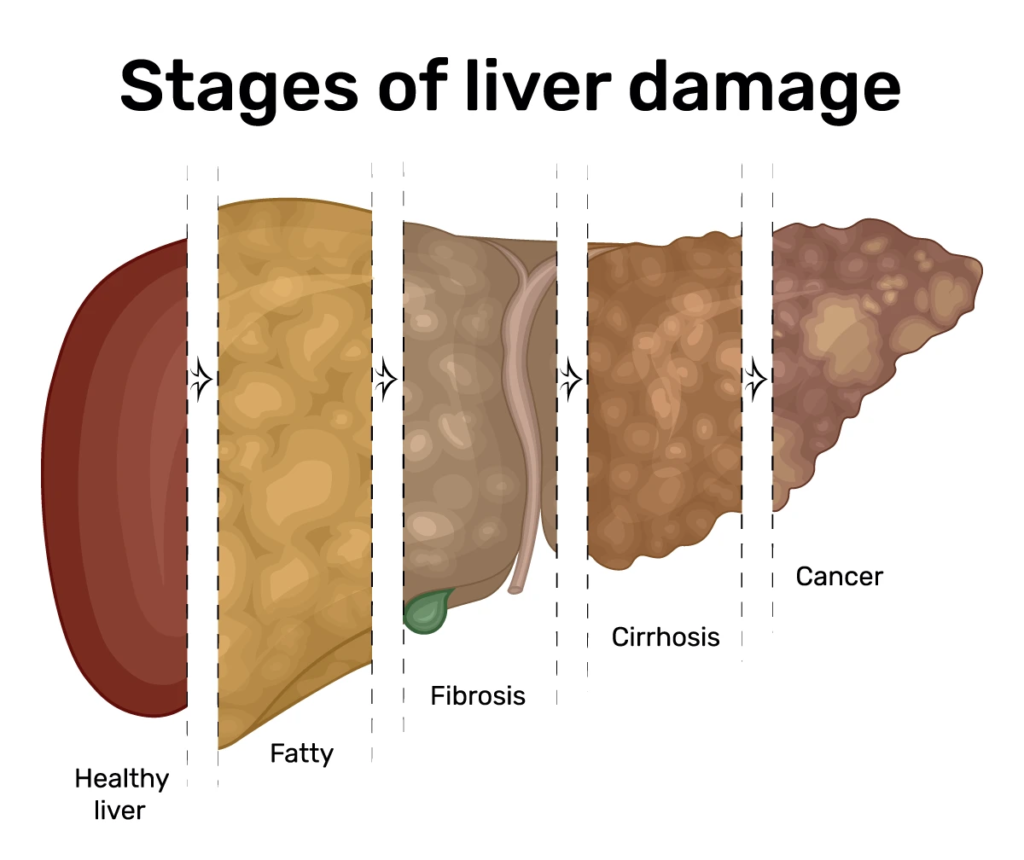
What are the stages of chronic liver disease?
First, consider the image above — it shows a healthy liver becoming “Fatty,” proceeding to then Fibrosis, Cirrhosis and Cancer.
Indeed, Non-Alcoholic Fatty Liver Disease (NAFLD) is associated with a 17-fold increased risk of HCC (Hepato Cellular Carcinoma). Read more here.
And yet, classically, chronic liver disease progresses in four (4) stages, as follows:
- Hepatitis.
- Fibrosis.
- Cirrhosis.
- Liver failure.
Stage 1: Hepatitis
Hepatitis means inflammation in your liver tissues; it’s your liver’s response to injury or toxicity. It’s also an attempt to purge infections and start the healing process. Acute hepatitis (an immediate and temporary response) often accomplishes this purging. But when the injury or toxicity continues, unfortunately so does the inflammation. Chronic hepatitis causes hyperactive healing that eventually results in scarring, also called fibrosis.
Note that a liver ultrasound, also known as a liver sonogram, is a completely painless imaging test that uses sound waves to create pictures of the liver and surrounding area to discern fat buildup, scarring, and more. It’s a noninvasive procedure that can help diagnose liver conditions, and takes <15 minutes in the outpatient setting, where an MA (Medical Assistant) conducts the test.
Stage 2: Fibrosis
Fibrosis is a gradual stiffening of your liver as thin bands of scar tissue gradually add up. Liver scarring occurs when collagen and other proteins build up in the liver.
Scar tissue reduces blood flow through your liver, which reduces its access to oxygen and nutrients. This is the how behind your liver’s vitality begins to gradually decline. Fortunately, some amount of fibrosis is reversible. Your liver cells can regenerate, and scarring can diminish if the damage slows down enough for it to recover.
Stage 3: Cirrhosis
Cirrhosis is severe, permanent scarring in your liver. Stage 3 is where fibrosis is no longer reversible. When your liver no longer has enough healthy cells left to work with, its tissues can no longer regenerate. But the damage at this stage can still be slowed or even stopped. Cirrhosis will begin to affect liver function, but the body will attempt to compensate for the loss, so you might not notice at first. Said another way, liver disease is more asymptomatic in its arc through stages than most disease states.
Stage 4: Liver Failure
Liver Failure begins when your liver can no longer function sufficiently for your body’s needs. This is also termed “decompensated cirrhosis” aka DC — your body can no longer compensate for the losses. As liver functions begin to break down, symptoms arise; the patient feels effects throughout the body. Chronic liver failure is a gradual process, but it is eventually fatal without a liver transplant. Of course, you need a liver to live.
